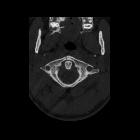Halswirbelsäulenverletzung
Cervical spine injuries can involve the cervical vertebral column, intervertebral discs and cervical spine ligaments, and/or cervical spinal cord. The cervical spine accounts for ~50% of all spinal injuries.
Epidemiology
5-10% of patients with blunt trauma have a cervical spine injury .
Pathology
Patients can have a combination of injuries including:
- atlanto-occipital dissociation
- occipital condyle fracture
- cervical spine fractures
- discoligamentous injury
- anterior subluxation (posterior ligamentous complex rupture)
- facet joint dislocation
- spinal epidural hematoma
- spinal cord injury
- vertebral artery dissection
Etiology
- blunt trauma: motor vehicle accident (40%), falls, sports injuries
- penetrating trauma: gun shot injuries, stabbing
Associations
- closed head injury: patients with GCS <8 at highest risk
Radiographic features
CT and MRI both have roles to play. CT is used to assess patients who are obtunded, at high-risk, or those unable to be cleared by clinical criteria (e.g. NEXUS criteria, Canadian C-spine rule).
The majority of patients are imaged while being immobilized in a cervical spine collar. If the CT is reported as negative, the collar is typically removed (cervical spine collar clearance). A select few patients nevertheless require further assessment with MRI.
MRI is used to assess for discoligamentous injury but has a controversial role in patients who are obtunded and a normal CT with some advocating it as unnecessary due to the CT's high negative predictive value for unstable cervical spine injuries .
Please see individual articles listed above for further details in imaging findings.
See also
Siehe auch:
- Frakturen der Halswirbelsäule
- Atlasfrakturen
- Fraktur Axis
- Halswirbelsäule Fraktur Klassifikation
- cervical spine nexus criteria
- cervical spine injury severity score (csiss)
- canadian c-spine rule
- HWS Schleudertrauma
- HWS-Verletzungen unterhalb des Axis
und weiter:

 Assoziationen und Differentialdiagnosen zu Halswirbelsäulenverletzung:
Assoziationen und Differentialdiagnosen zu Halswirbelsäulenverletzung:


